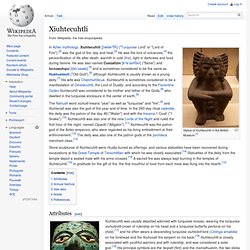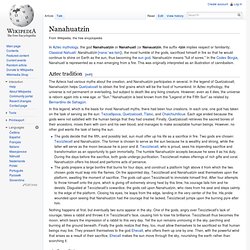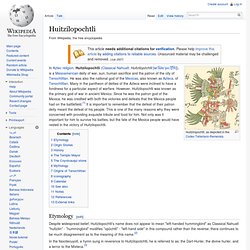

Xiuhtecuhtli. Statue of Xiuhtecuhtli in the British Museum.[1] In Aztec mythology, Xiuhtecuhtli [ʃiʍtekʷt͡ɬi] ("Turquoise Lord" or "Lord of Fire"),[2] was the god of fire, day and heat.[3] He was the lord of volcanoes,[4] the personification of life after death, warmth in cold (fire), light in darkness and food during famine.

He was also named Cuezaltzin [kʷeˈsaɬt͡sin] ("flame") and Ixcozauhqui [iʃkoˈsaʍki],[5] and is sometimes considered to be the same as Huehueteotl ("Old God"),[6] although Xiuhtecuhtli is usually shown as a young deity.[7] His wife was Chalchiuhtlicue. Tonatiuh. In Aztec mythology, Tonatiuh (Nahuatl: Ōllin Tōnatiuh [oːlːin toːˈnatiʍ] "Movement of the Sun") was the sun god.[1] The Aztec people considered him the leader of Tollan, heaven.

He was also known as the fifth sun, because the Aztecs believed that he was the sun that took over when the fourth sun was expelled from the sky. Description[edit] Aztec theology held that each sun was a god with its own cosmic era, the Aztecs believed they were still in Tonatiuh's era. According to the Aztec creation myth, the god demanded human sacrifice as tribute and without it would refuse to move through the sky. It is said that 20,000 people were sacrificed each year to Tonatiuh and other gods, though this number is thought to be inflated either by the Aztecs, who wanted to inspire fear in their enemies, or the Spaniards, who wanted to vilify the Aztecs.
Teoyaomicqui. Stone statue of Cihuacoatl, showing her framed by the mouth of a serpent, holding an ear of maize in her left hand.

In Aztec mythology, Cihuacoatl [siwaˈkoːaːt͡ɬ] ("snake woman"; also Cihuacóatl) was one of a number of motherhood and fertility goddesses. [nb 1][1] Cihuacoatl was sometimes known as Quilaztli.[2] Although she was sometimes depicted as a young woman, similar to Xochiquetzal, she is more often shown as a fierce skull-faced old woman carrying the spears and shield of a warrior.[3] Childbirth was sometimes compared to warfare and the women who died in childbirth were honored as fallen warriors. Their spirits, the Cihuateteo, were depicted with skeletal faces like Cihuacoatl. Like her, the Cihuateteo were thought to haunt crossroads at night to steal children.[3] Nanauatzin. In Aztec mythology, the god Nanahuatzin or Nanahuatl (or Nanauatzin, the suffix -tzin implies respect or familiarity; Classical Nahuatl: Nanāhuātzin [nanaːˈwaːtsin]), the most humble of the gods, sacrificed himself in fire so that he would continue to shine on Earth as the sun, thus becoming the sun god.

Nanahuatzin means "full of sores. " In the Codex Borgia, Nanahuatl is represented as a man emerging from a fire. This was originally interpreted as an illustration of cannibalism. Aztec tradition[edit] The Aztecs had various myths about the creation, and Nanahuatzin participates in several. In this legend, which is the basis for most Nanahuatl myths, there had been four creations. The gods decide that the fifth, and possibly last, sun must offer up his life as a sacrifice in fire. Nothing happens at first, but eventually two suns appear in the sky. Pipil tradition[edit] Sources[edit] Jump up ^ ANCIENT AMERICA, 9 = Ruud van Akkeren : Tzuywa : Place of the Gourd. Huitzilopochtli. In Aztec religion, Huitzilopochtli (Classical Nahuatl: Huītzilopōchtli [wi:t͡siloˈpoːt͡ʃt͡ɬi]), is a Mesoamerican deity of war, sun, human sacrifice and the patron of the city of Tenochtitlan.

He was also the national god of the Mexicas, also known as Aztecs, of Tenochtitlan. Many in the pantheon of deities of the Aztecs were inclined to have a fondness for a particular aspect of warfare. However, Huitzilopochtli was known as the primary god of war in ancient Mexico. Since he was the patron god of the Mexica, he was credited with both the victories and defeats that the Mexica people had on the battlefield.[1] It is important to remember that the defeat of their patron deity meant the defeat of his people. This is one of the many reasons why they were concerned with providing exquisite tribute and food for him. Aztec mythology.